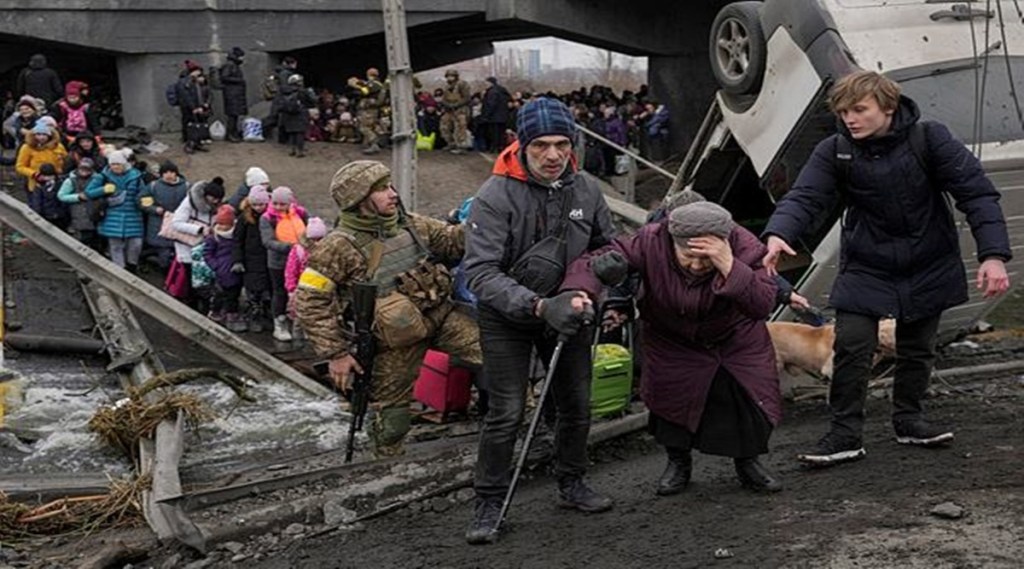By Prashant Dikshit
Russia is unrelenting in its commitment of writing the epitaph of the democratic Ukraine. They commenced their invasion of Ukraine on 24th February 2022 from the victim country’s east with tanks and gunships carrying Russian special forces. A few days later an invading armada of tanks came in from the Northern Belarus border. The latest is that similarly armed Russian troops entered from the Southern Crimean border. Their occupational military doctrines have remained consistent since decades. Tanks roll down roads leading to urban centers, bombard indiscriminately and instill fear in the common populace. This is what the Sovietarmy did in Hungary in 1956 when tanks crept along main roads firing indiscriminately into buildings. This practice was repeated when Soviet Russia led a combined force from Bulgaria, Poland and Hungary into Czechoslovakia in 1968 under Brezhnev. We also have the somewhat out-of-date example of the Soviet invasion of Poland in 1939 which I am sure continues to be taught in Russian military schools. Although, whether the Russian copy book campaign will deliver its political objectives is yet to be seen.
According to a British defense ministry statement ,“Ukrainian Air Force and air defense forces are continuing to effectively defend Ukrainian airspace and Russia has failed to gain control of the air and is largely relying on stand-off weapons launched from the relative safety of Russian airspace to strike targets within Ukraine,” Use of air power and ballistic missile was the only addition to earlier campaigns which does not seem to delivering. A US reportstates the initial Russian onslaught included more than 100 missiles launched from land and sea.Some cities in the southern Ukraine were hit by Kalibr cruise missiles launched from the Russian Naval ships in the Black Sea. This missile has a range of 1500 to 2000 kms but a stated strike accuracy of 5 meters. In reality, that does not seem to be very effective.
Ukraine claims that Russia has now lost eighty-one planes, ninety-five helicopters, and nine unmanned aerial vehicles. Numerous photos and videos confirm many of the Russian aircraft losses whilst many aircraft would have crashed in Russian territory .The bulk of aircraft losses are believed to be from surface-to-air missiles (SAMs), including from the mobile, long-range S-300 (aka SA-10) and from shoulder-fired man portable air defense systems (MANPADS) such as the Stinger missile supplied by the United States. Amazingly despite the Afghanistan experience, Russia has not modified its ground-attack tactics and is conducting many of its attacks at low altitude, within the lethal envelope of MANPADS. No air superiority and therefore minimal support to the ground invasion force.
Although Russia is still flying about two hundred sorties per day, many of those combat missions remain outside of Ukrainian airspace.The Ukrainian Air Forceis down to approximately fifty-six combat aircraft and it cannot fly more than ten sorties per day.
The ground war waged by Russians may have come to a standstill. Their troops are now resorting to “sieges” of cities; Kyiv, Kharkiv and Mauripol. There is extensive damage and casualties in Kharkiv, Ukraine’s second-largest city. In the two main fronts in the east and north, Russia so far has little to show for its advance, with Ukraine’s two biggest cities, Kyiv and Kharkiv, holding out in the face of increasingly intense bombardment.
Russian forces are now confronted with Guerilla Warfare, the standard tool for an asymmetric war . Buildings and trees in densely populated areas serve as hiding places for the Ukrainian soldiers.Ukraine has received a variety of hardware, advanced weapons that can destroy armoured vehicles, particularly effective in urban settings, with more opportunities for teams to conceal, fire and forget. Among these weapons are the NLAW, the next-generation antitank missile system developed jointly between UK and Sweden, and the FGM-148 Javelin, a U.S. lightweight system that can destroy tanks from several kilometers away.
Road signs are being removed to make it difficult for Russian soldiers to orient themselves. The Ukrainian government is using social media to share instructions on how to throw Molotov cocktails at vulnerable areas of Russian vehicles. Ukrainians have made metal anti-tank barricades known as “hedgehogs”, and smaller spiked barriers aimed at stopping wheeled vehicles. Civilians are supporting regular troops with independent militia that has sprung up across Ukraine.
The Ukrainian Armed Forces’ use of the Bayraktar TB2 unmanned combat aerial vehicle has been very productive. It is a Turkish-made drone that can carry small anti-armor weapons. They were being used to destroy vehicles in Russian convoys.
Meanwhile Ukraine has evacuated nearly 200000 civilians from frontline areas via humanitarian corridors since the start of Russia’s invasion of Ukraine.Corridors in the Kyiv and Luhansk regions were functioning on Saturday the 12th, but a planned corridor to the besieged eastern port city of Mariupol was only partially operational, with buses not being allowed through by Russian troops.
The United States and countries of the European Union have principally relied on sanctions and publicly espoused persuasion to prevail over Russia to declare a ceasefire immediately and come to the discussion table. But there are only conciliatory statements coming from the Russian leadership. Although that is being seen as a very positive development, the situation on ground in Ukraine remains intensely hostile and dangerous. The Russians, it would seem, are merely buying time.
(The author is a strategic affairs commentator. Views expressed are personal and do not reflect the official position or policy of Financial Express Online. Reproducing this content without permission is prohibited).

